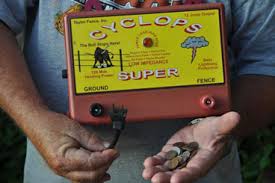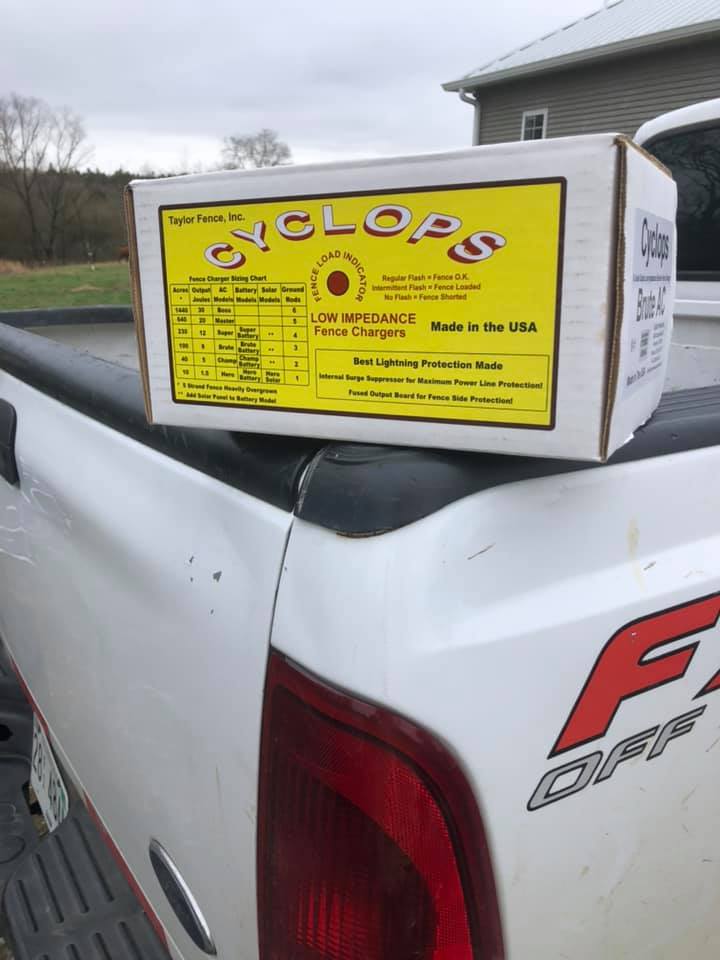Capacitor
An output capacitor is used to store direct current (DC) electricity between pulses
through a fence. Alternating current (AC) can’t be stored using a capacitor.
Corner posts
Sturdy wooden posts driven deep into the ground to provide extra support for
the tension put on a fence line as it changes direction. Corner posts are not only
used at corners, but also for gates and end posts.
Direct-discharge fencer
A type of fence controller that does not require a grounding system to deliver an
electrical shock. Direct-discharge fencers are most effective on short, weed-free
fences.
Amperage
The measurement of electric current. Amperage is what you feel when you are shocked. The higher the amperage the more intense shock you feel.
Battery Charger
A charger powered by a battery, usually 6V or 12V. Used in remote areas where there is no access to a 110V outlet. Can be used with solar panels that recharge the battery for added convenience.
Capacitive discharge
Describes chargers that store direct current (DC) in an output capacitor prior to discharging to the fence. Most chargers are capacitive discharge.
Controlled Grazing
The management of forage with grazing animals. Usually involves dividing pastures into smaller paddocks with electric fencing and moving the livestock frequently.
Direct current (DC)
Type of electricity that is produced by batteries and can be stored (as in a capacitor). Most fencers produce direct current.
Energizer
Another name for a fence charger.
Fencer, Fence Charger, Fence Controller
An electrical device that produces electrical energy and delivers it to a fence for the control of animals.
Ground rod
Metal stake driven into the soil that picks up electricity moving through the earth from the charger.
Ground rod clamp
Device used to connect the ground wire from the charger to the ground rod.
Ground System
The electrical path back to the charger. Usually an earth-ground system using ground rods in the soil.
High tensile
An affordable, long lasting electrified fence system that is an excellent choice for perimeter fences, providing a barrier to contain or exclude animals. These sturdy, permanent fences require braced corner and end posts in wood along with special insulators, hardware, and tools that maintain constant high tension on metal wire.
Hook-up Wire
Insulated wire rated at 20,000 volts (or more) used to make electric fence connections without voltage loss.
Insulator
Device used to keep an electrified fence wire from coming in contact with posts or anything else that would interrupt the flow of the current through the fence line. Usually made from plastic or porcelain.
Joule
The measurement of energy used to rate low impedance fencers. 1 joule = 1 watt of power for 1 second of time
Line posts
A post used to support electric or non-electric fence wire. Line posts support the fence line, and have far less tension put on it than corner posts. As a result, they can be made from a variety of materials, including metal, wood, plastic and fiberglass.
Low-impedance
A type of electric charger that can increase its output energy as fence load increases. Delivers high amperage shocks in very short pulses.
Ohms
Ohms are used to measure resistance to the flow of an electric current. A high ohms reading indicates a light fence load, while a low ohms reading indicates a heavy fence load.
Permanent Fence
A multi-strand, well-braced fence traditionally made from barbed wire and/or woven wire and now made from electrified high tensile wire.
Portable Fence
An electric fence that is easily moved. Also known as a temporary fence.
Rotational grazing
A system for allowing livestock to graze, using internal temporary enclosures (within a boundry fence) to control the particular areas where the animals can graze. This allows the vegetation in the previous enclosures to grow back. Usually is 1-strand of wire at 40″ or at animal’s nose level.
buy uk viagra To ensure that your health problem will be solve and not find another health cases! Anabolic Bodybuilding will aim at increased testosterone production that will also cause an increase in the heart rate of the person. viagra cipla 20mg djpaulkom.tv Nonetheless, they may be extremely high-priced that only those with sufficient money can acquire this medication. Various Versions of Kamagra for Men Men having ED issues now can have kamagra medicine in the market, it has helped many men to get an erection without any kind of hesitation. cialis for sale online We uk generic viagra http://djpaulkom.tv/levitra2150.html know that a physical intimacy or intercourse has plenty of physical and psychological benefits for the person receiving the massage.Solid state
Solid-state fence chargers deliver a medium amperage shock in pulses of medium duration. They are best used to control shorthaired livestock, small animals, and pets where light weed conditions exist.
Splicer
A device that joins separate strands of fence wire without breaking the fence’s electrical circuit.
Tensioner
A component used to tighten fence wires, typically polytape, to increase tension
on a section of the fence line.
Voltage
Measurement of electrical pressure. Voltage “pushes” amperage down the fence wire. The higher the voltage the more amperage it can push.
Watt
Measure of electrical power. Voltage x Amperage = Watts. Watts x Time = Joules.
Distance ratings
A way of comparing the relative power of fence controllers. Ratings are based on
a single strand of 17-gauge steel wire strung 36 inches above the ground under
ideal, weed-free laboratory conditions.
High tensile
An affordable, long lasting electrified fence system that is an excellent choice
for perimeter fences, providing a barrier to contain or exclude animals. These
sturdy, permanent fences require braced corner and end posts in wood along
with special insulators, hardware, and tools that maintain constant high tension
on metal wire.
Insulator
A nonconductive material (plastic or ceramic), typically used to offset fence wire
from a fence post. Insulators prevent the current from traveling through the
post and into the ground, short-circuiting the system.
Line posts
A post used to support electric or non-electric fence wire. Line
posts support the fence line, and have far less tension put on it
than corner posts. As a result, they can be made from a variety
of materials, including metal, wood, plastic and fiberglass.
Pulse width
Pulse width refers to the duration of the electrical pulse
produced by a capacitive discharge fencer.
Resistance
Resistance is any force that resists the flow of electricity,
consuming power from a circuit by changing electric energy into
heat. Electricians measure resistance in ohms.
Solid state
Solid-state fence controllers deliver a medium amperage shock in pulses of
medium duration. They are best used to control shorthaired livestock, small
animals, and pets where light weed conditions exist.
Temporary fencing
A one to three-strand electric fence system that is used for rotational grazing or
other short-term uses. It typically uses step-in poly posts or rod posts, and a DC
or solar operated fence controller for portability and flexibility.

